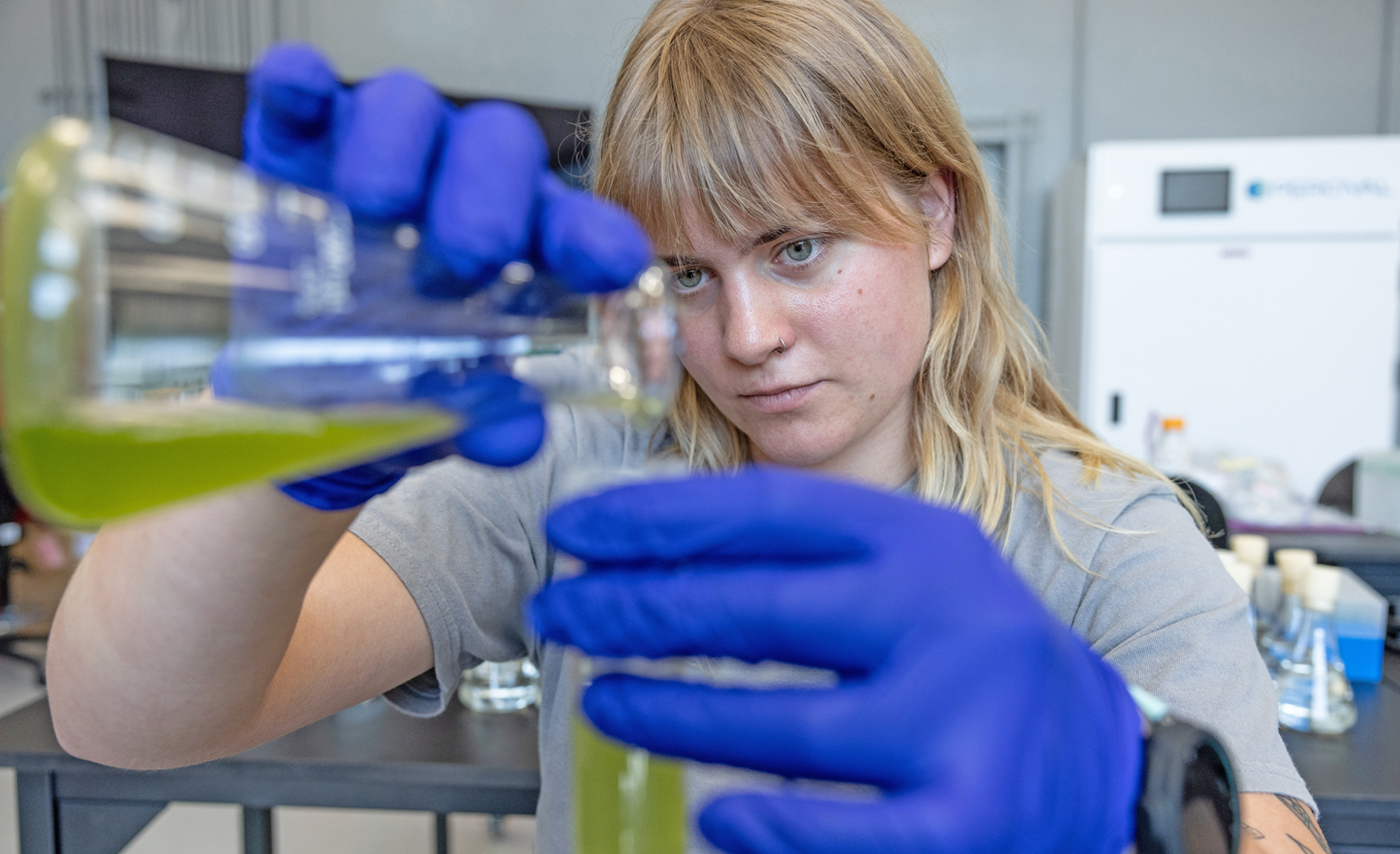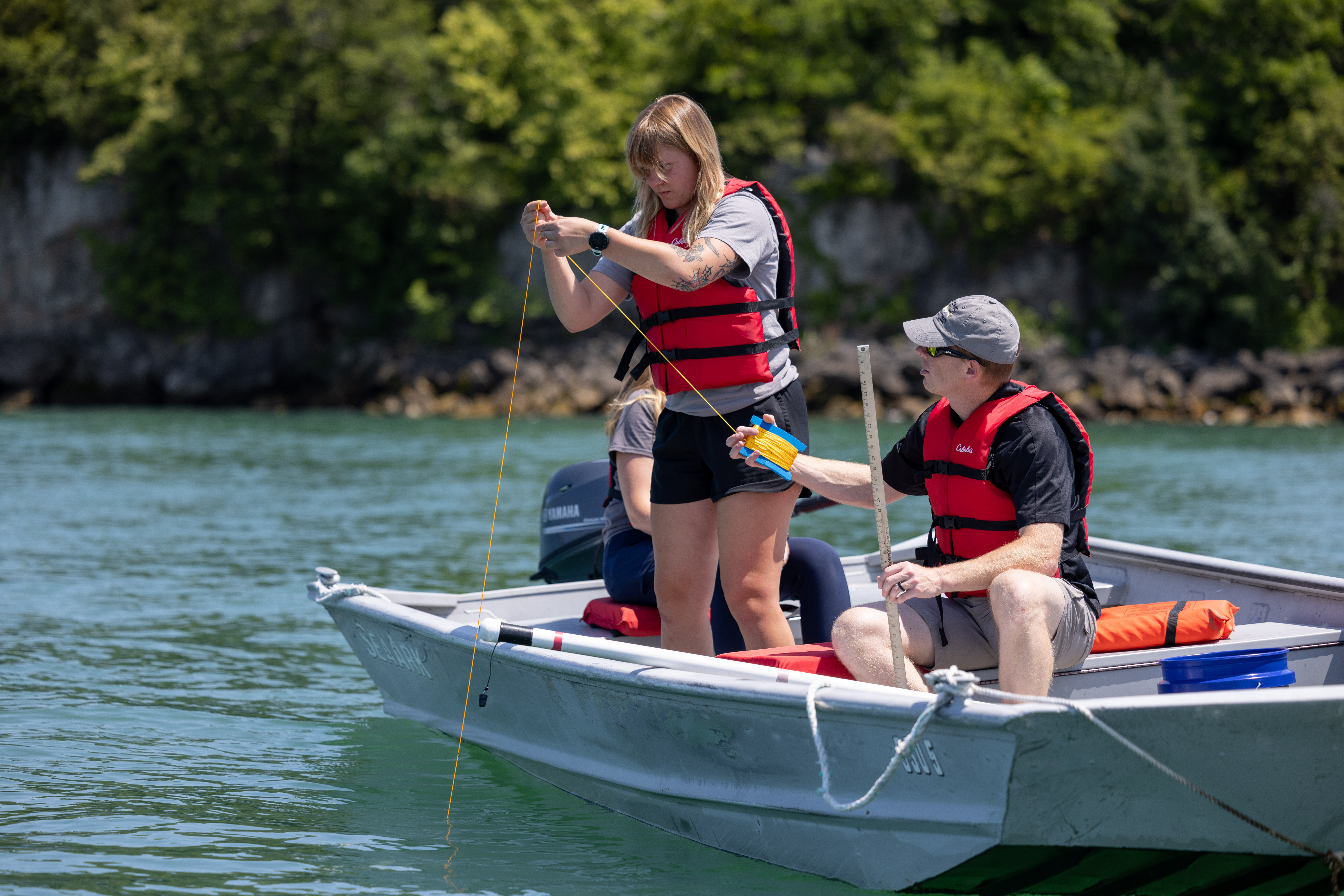From rower to researcher
Alex discovered her passion, her community for water quality science at Stone Lab’s research facility.

The mayflies are swarming as the sun begins to set on Lake Erie.
Alex Kushnir is paddling through the water in a kayak between Gibraltar Island and Put-In-Bay harbor, where Ohio State’s Stone Laboratory research center is based.
It’s on the water where Alex finds peace. And it’s at Stone Lab where she found her path toward becoming a researcher that will improve water quality for generations to come.
“I want to make sure people can enjoy a beautiful place like Lake Erie without something like harmful algae blooms,” says Kushnir, a senior Ohio State rower and environmental science major who spent the past two summers at Stone Lab, which is part of the School of Environment and Natural Resources. “I love the lake, I love the people here. Being a student, researching here, It’s helped me grow so much as a person.
“I found my passion here, I found my place here. Being surrounded by people who truly love what they’re doing, they’ve become a second family.”
Kushnir’s first family is about 4,500 miles away in her hometown of Ravenna, Italy, near the coast of the Adriatic Sea. It was on that coast Kushnir discovered her first love, rowing. Her athletic skills landed her in a boat on the Italian national team, competing on the international level.
“As a kid I tried a bunch of sports but never got passionate until I tried rowing,” Kushnir says, “Being on a boat on water always fascinated me.”
One of Kushnir’s international teammates was Alessandra Montesano ’23, an Ohio State rower and Italian Olympian. Kushnir, a first-generation college student, was recruited to row at Ohio State with Montesano’s help and encouragement.
While the recruitment process was seamless, the timing of her arrival in Columbus wasn’t. Kushnir arrived on Ohio State’s campus in January 2021, at the height of COVID-19 shutdowns, not fluent in English and surrounded by land. Her only familiar ground was actually the water, rowing on the Scioto River with her teammates.
“It was a challenge, I’m not going to lie,” Kushnir recalls. “Everything was online. I wasn’t used to being surrounded by land. But my teammates have been amazing. We do so many hard things together, but it bonds us. It’s been really rewarding.”
As she acclimated to Columbus and Ohio State, she found a path outside rowing as well. Originally a landscape architecture major, she took an environmental science class. That opened her eyes to the possibilities of a career in water science research.
“I've really enjoyed it because I spend time in the lab but also get out on boats on the water,” she says.

Learning, making an impact at the island laboratory
It wasn’t long after that she saw a line in a campus newsletter about a new opportunity for students: a semester at Stone Lab. After being selected to live on the island laboratory as a student following her sophomore year, she found her second home.
Kushnir not only devoured the Stone Lab coursework, she volunteered for every opportunity. She helped Ohio State researchers, such as Justin Chaffin and his student MK Rinderle, with water quality research along with other students in Suzanne Gray’s aquatic physiology ecology lab studying fish.
Gray was her advisor for the semester and has since become a mentor to Kushnir.
“She shows so much drive and passion for preserving environments, she's not just checking a box.”
“Everyone kept telling me (that first summer) about all the initiative she was showing,” Gray says. “You don’t get students every day who are so passionate about the work that they’ll give up their free time to dissect fish brains, but she was doing that. She shows so much drive and passion for preserving environments, she’s not just checking a box.
“Since then, she’s become an integral student in my lab, helping other students learn, recruiting them, anything she can do. She’s just been wonderful.”
Kushnir also impressed Chaffin, a harmful algal bloom expert and the coordinator of Stone Lab’s Research Experience for Undergrads (REU) program. The REU program selects four students to oversee their own eight-week research project—from the initial idea to the full scope of research. Students can even work toward publishable papers after the project ends.

Kushnir’s work that first summer at Stone Lab helped Chaffin select her for his Limnology research project this past summer.
“She’s an all-around great student to work with because she’s highly motivated and willing to learn,” Chaffin says. “When you think about how she started at Ohio State, that had to be extremely challenging. But she’s a great example of how you can overcome those challenges and succeed if you take advantage of opportunities.”
Kushnir’s research project at Stone Lab this summer was a piece of a large study led by Ohio State’s Jim Hood and researchers like Chaffin to better understand phosphorous runoff from northeast Ohio land into the Maumee River, which runs into Lake Erie and causes harmful algal blooms.
Kushnir’s research is part of an innovative state-led research collaboration among 12 universities to solve the HABs problem. Phosphorous runoff is a primary driver of harmful algal blooms, which can have a major impact, such as in 2014 with the Toledo water crisis. About 12 million people get their drinking water from Lake Erie, which also supports a $2 billion dollar fishing industry that can be crippled by harmful algal blooms.
“(The overall project) is looking at the source of harmful algal blooms, how the land affects Lake Erie and how we can improve maintenance practices and forecasting blooms,” she says. “It has definitely been a challenge but I love challenges like this.”
It's the type of research Kushnir hopes to do throughout her life, encouraging sustainable practices through diligent research.
“I’ve been so grateful to have mentors like Justin and Suzanne and the people here at Stone Lab,” Kushnir says. “Everyone here is so passionate about their work and their research is making an impact. I want to make that same impact with my life.”